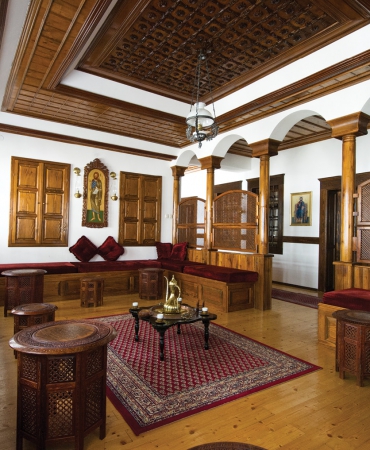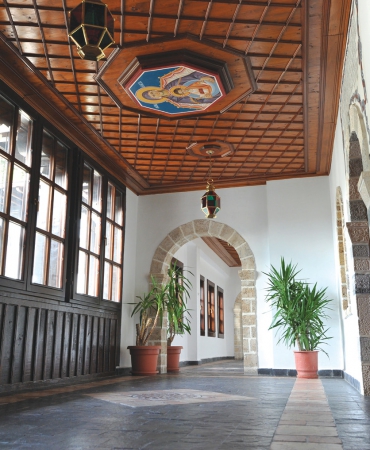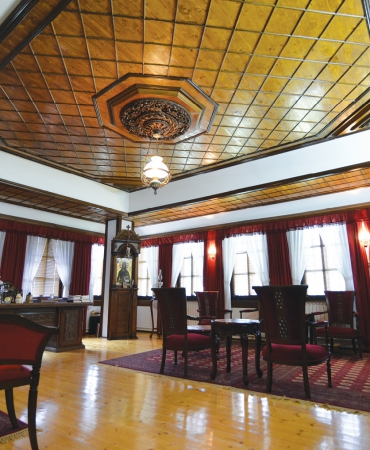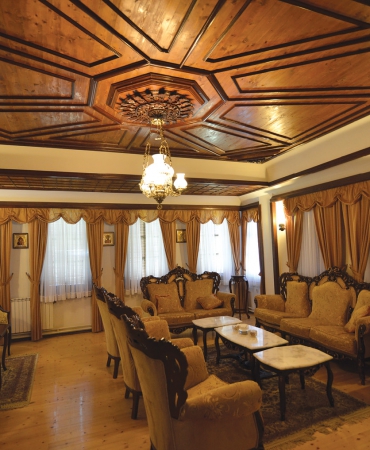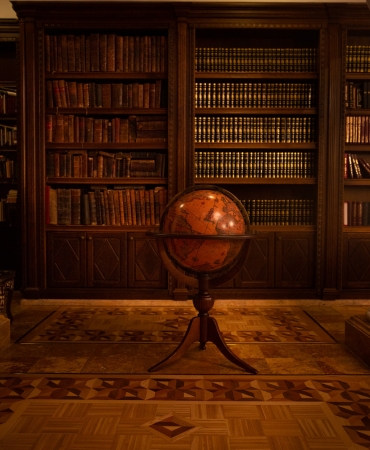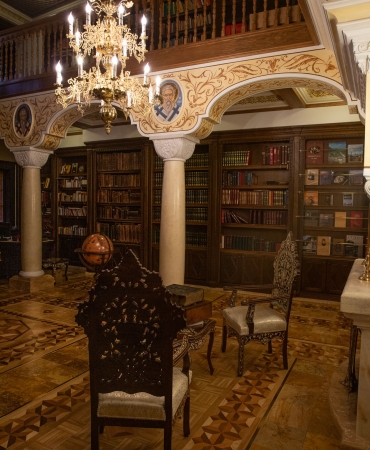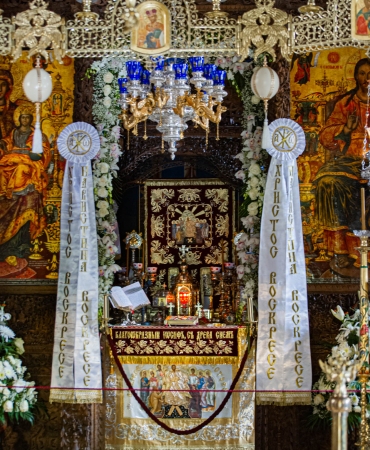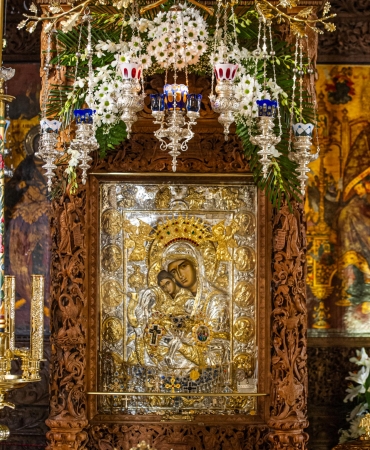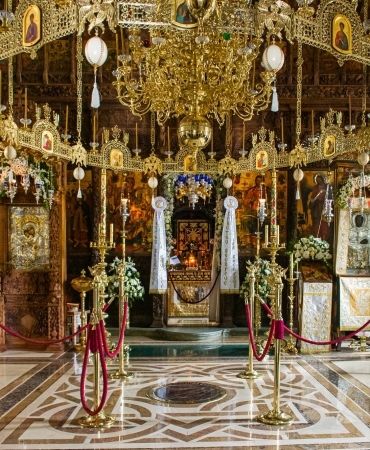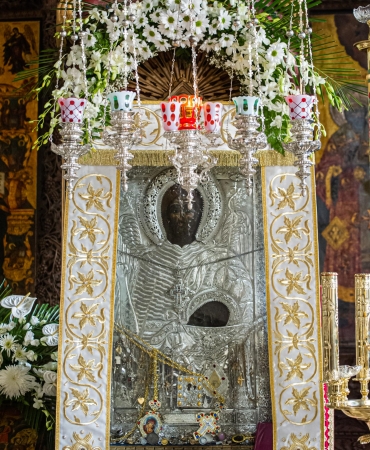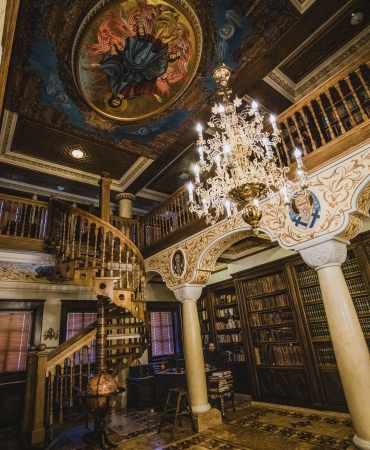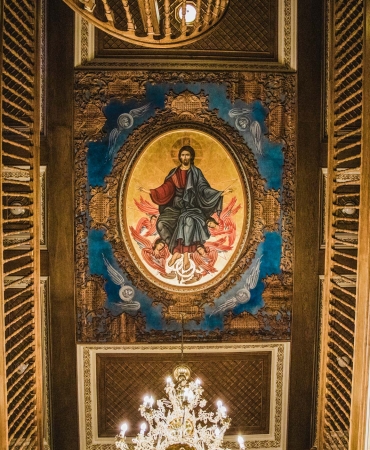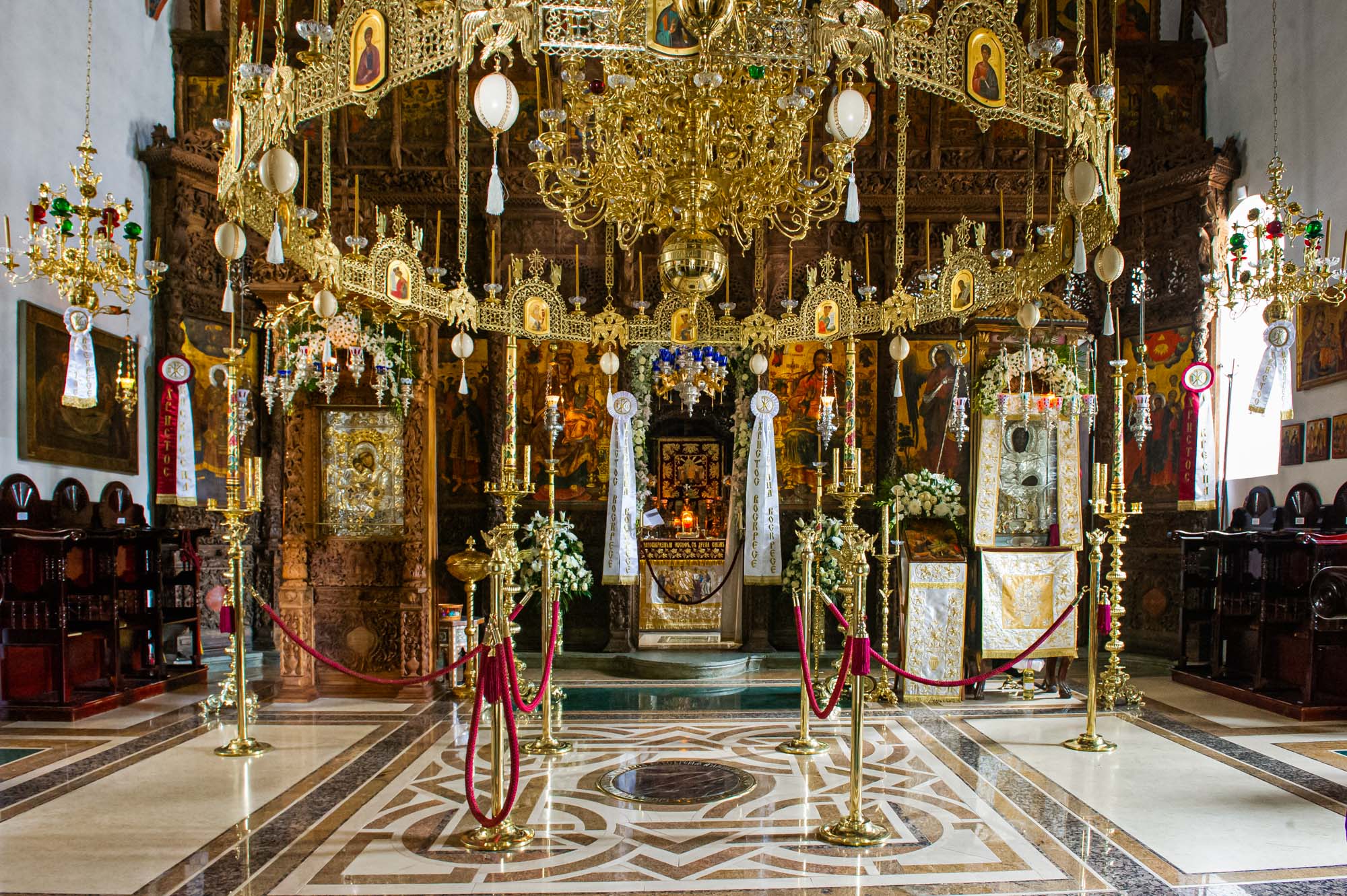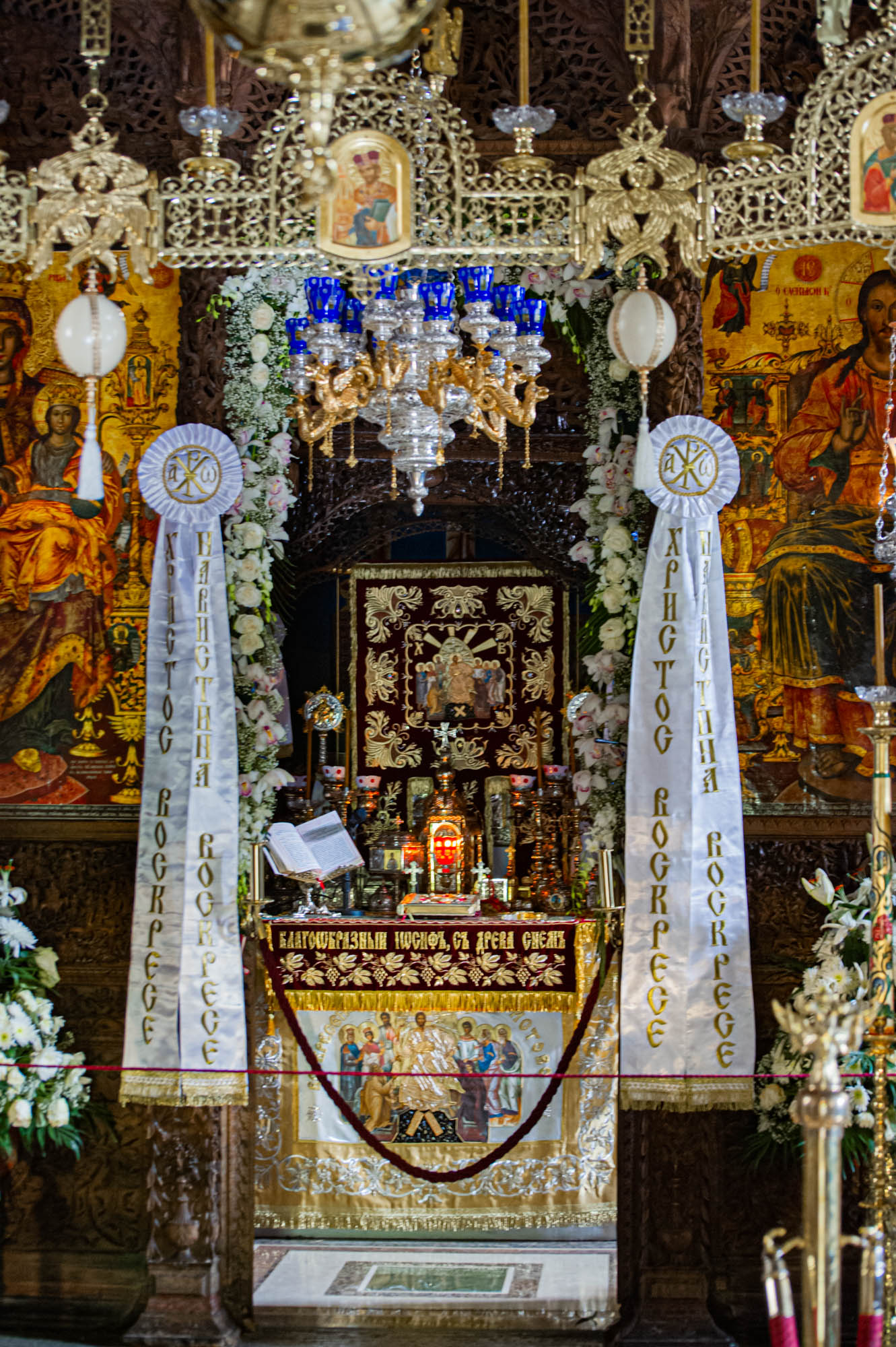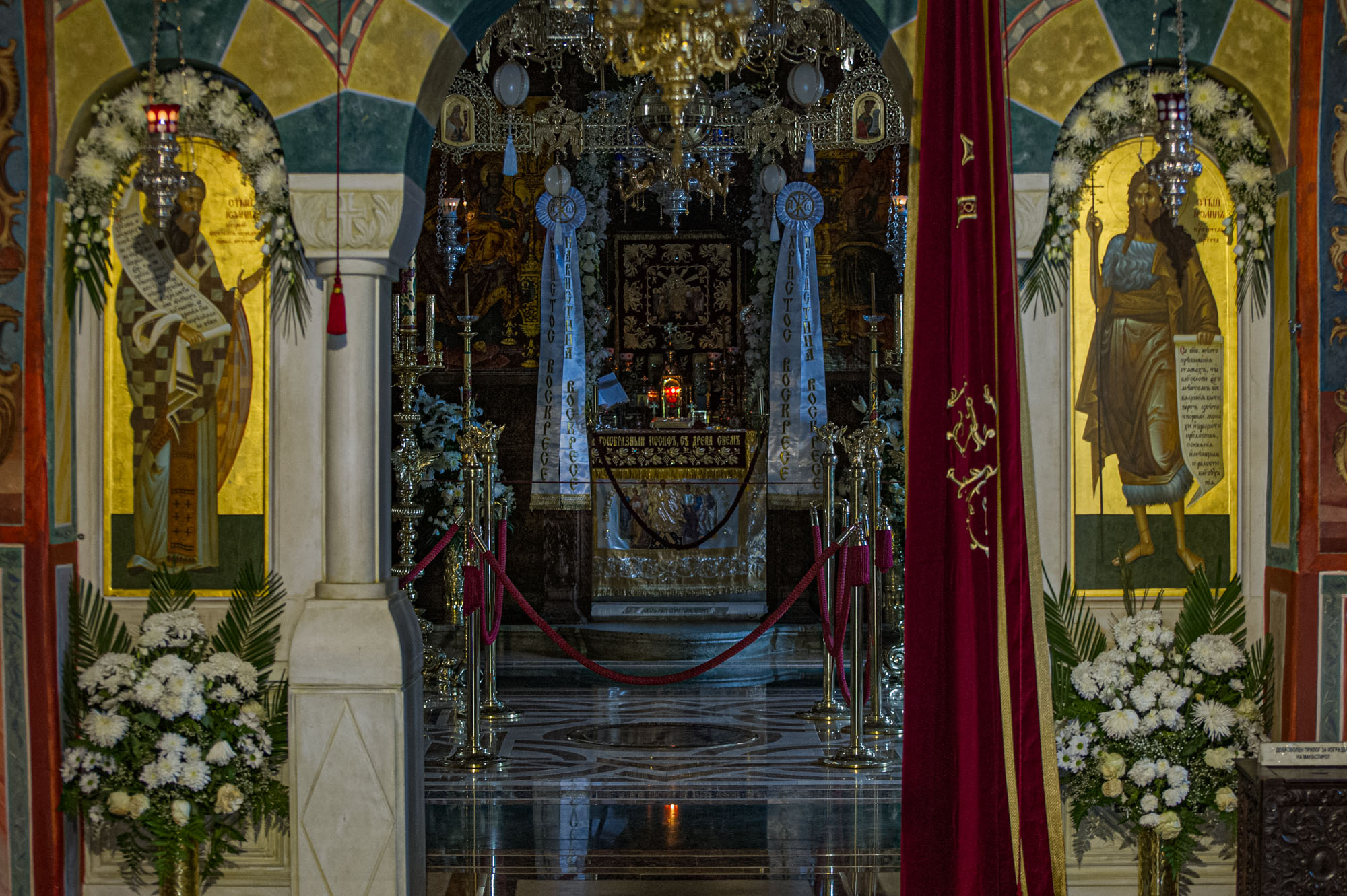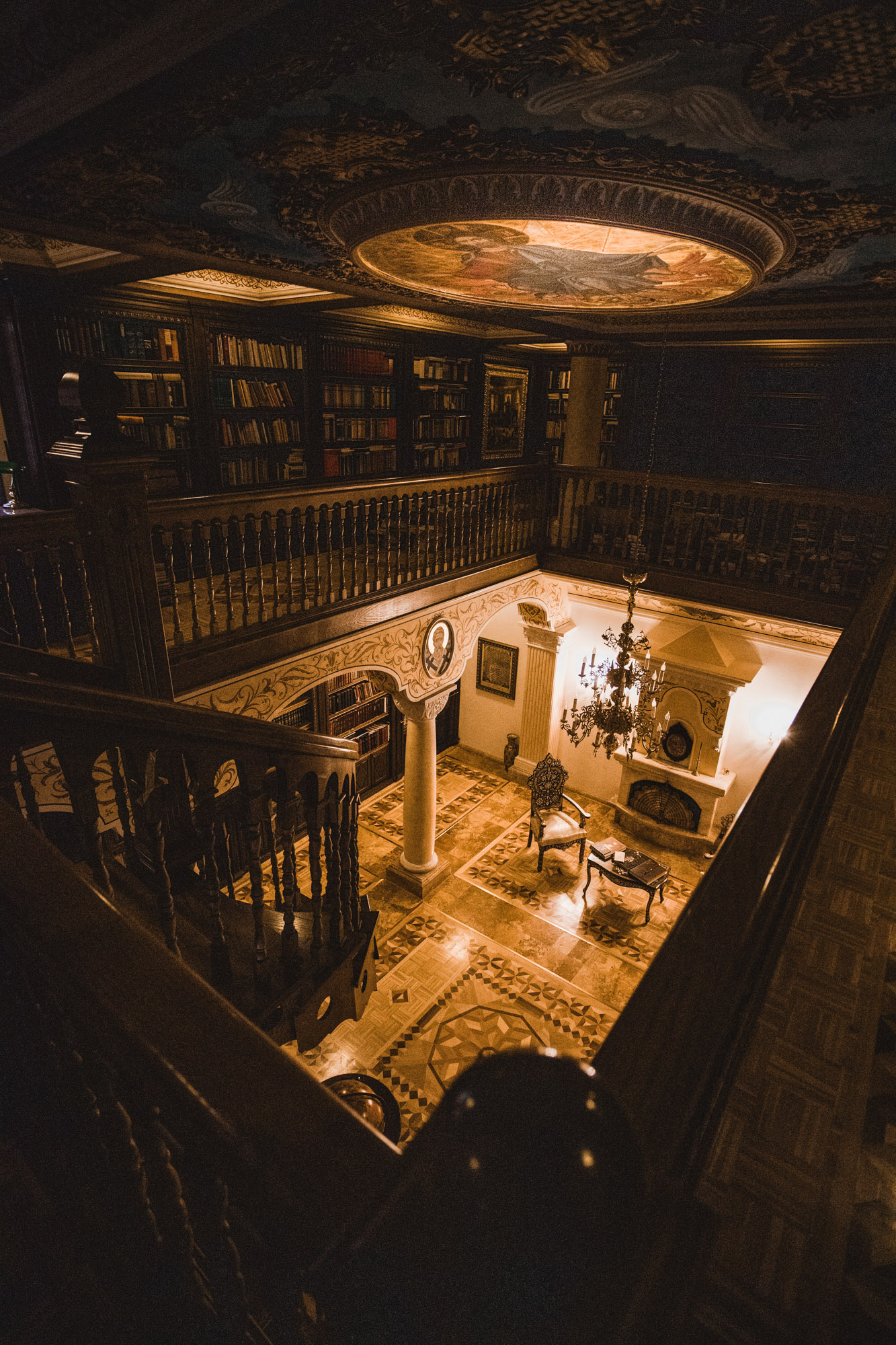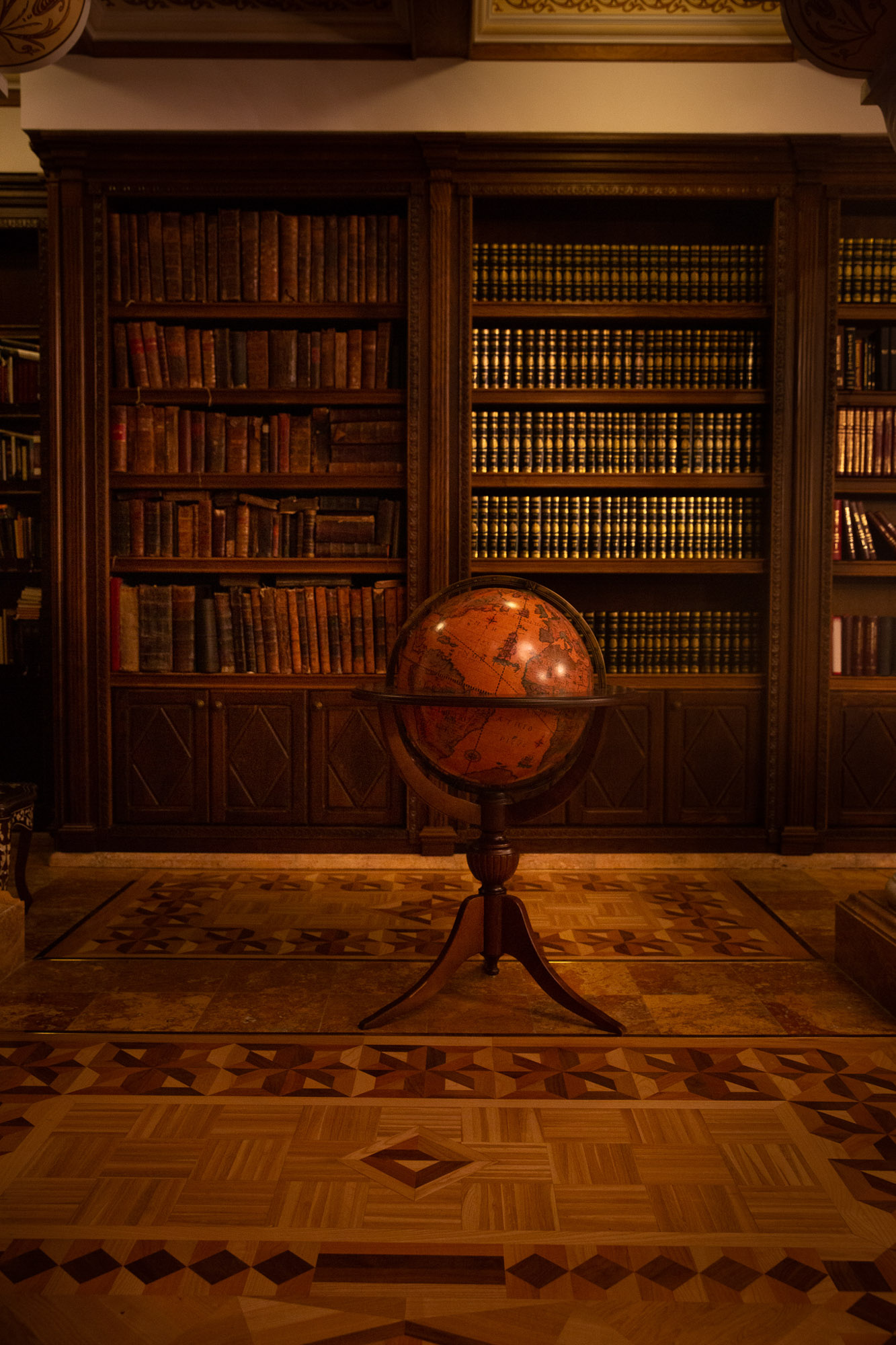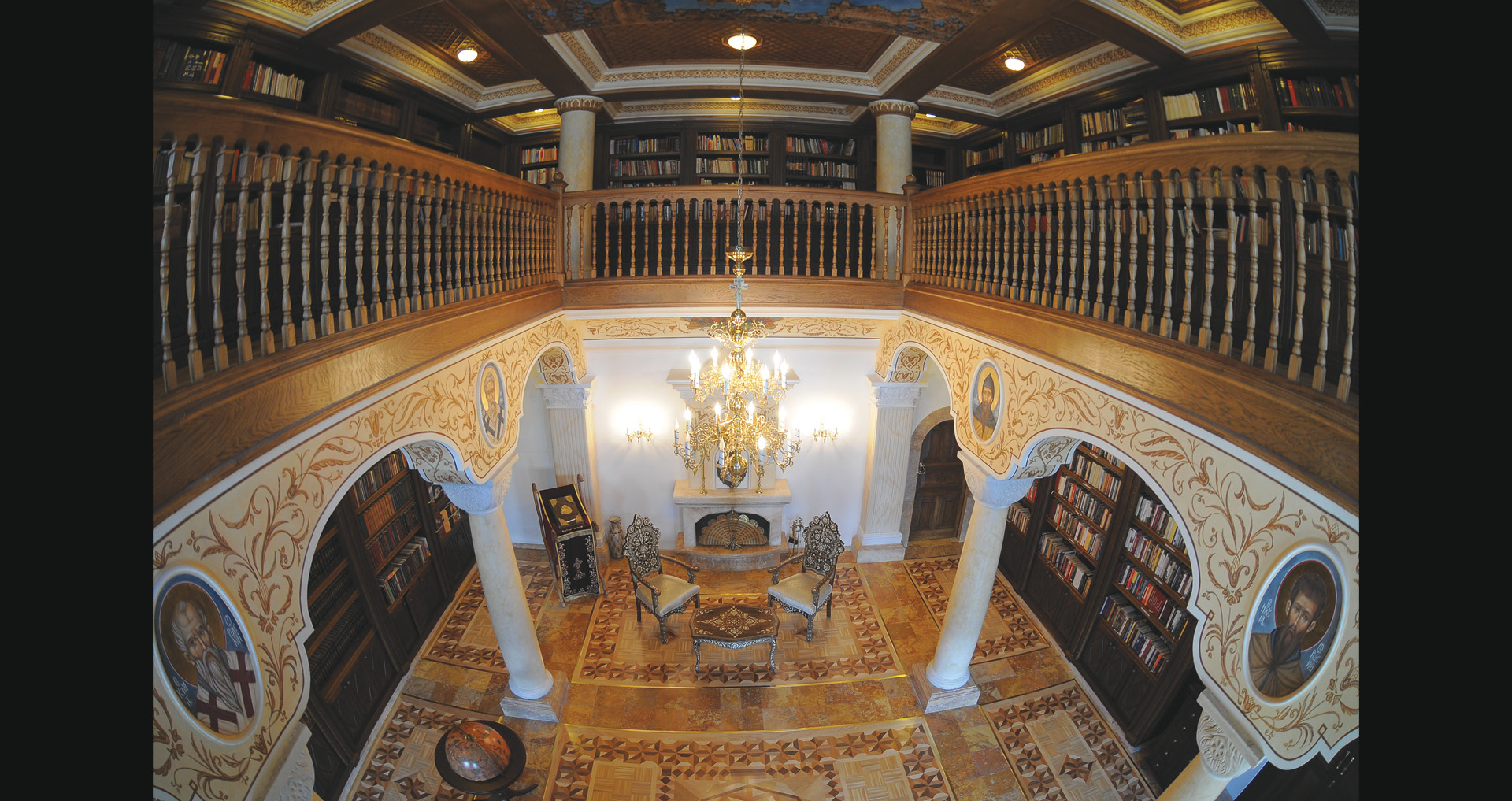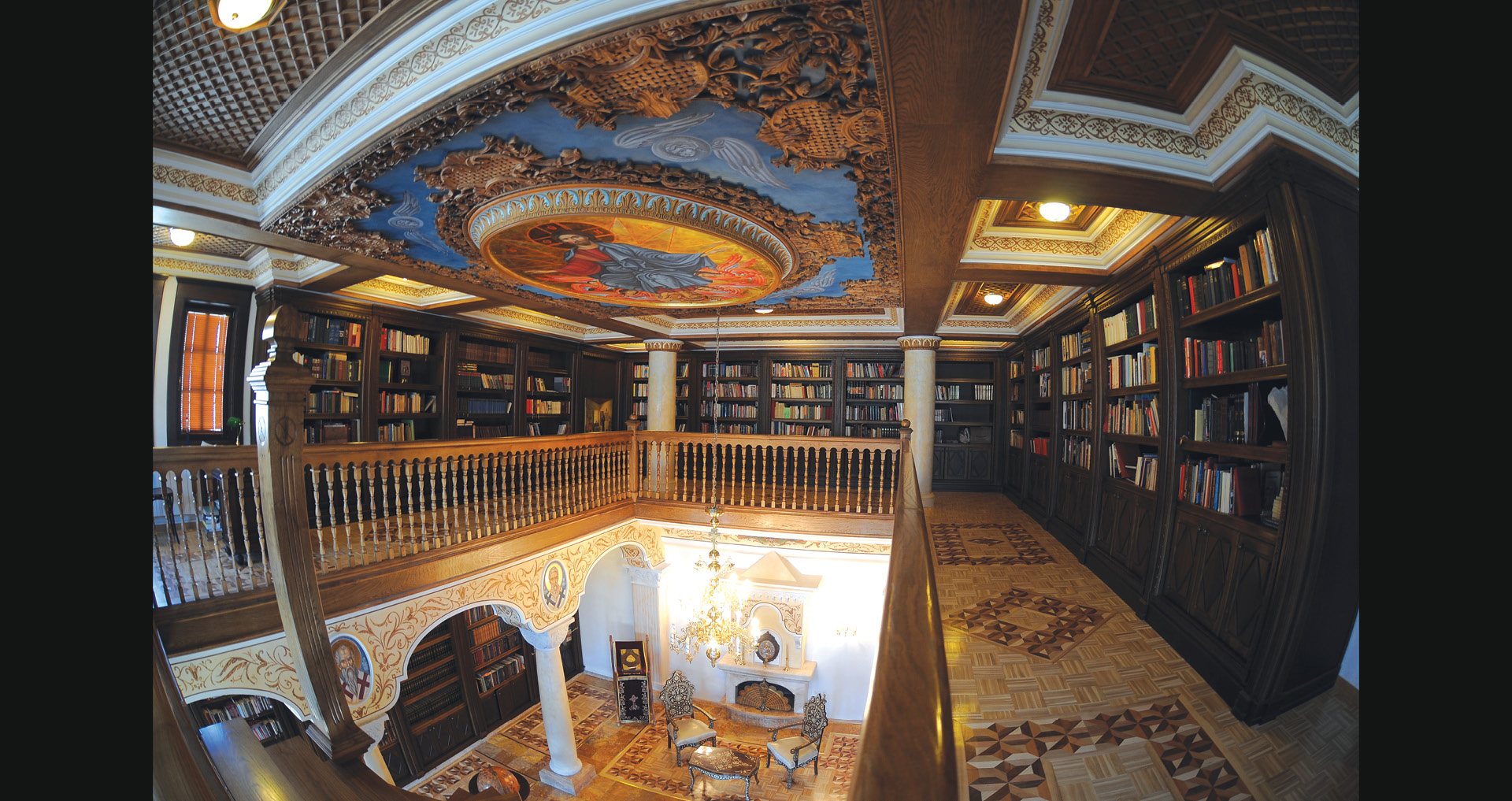The Catholicon
As in every other monastery built in the image of the City of God – the Heavenly Jerusalem, here, in the Bigorski monastery, also, the central place is occupied by the cathedral church – the Catholicon. The church was built at the end of the XVIII century, in a unique architectural style, which is typical only for the Miyak architecture from the Revival period and it is a style conditioned and limited by the severe regulations imposed by the contemporary Ottoman Shari’a laws. Even though, according to its external architecture, the Bigorski Catholicon is a modest one dome building, it is still one of the first bigger temples from the period after the Ottoman occupation. The grandeur of the Catholicon is due to the fact that its construction was approved by a special Ferman (screed) – a license issued personally by the Sultan. The church is a deed of master builders, wood carvers and painters from the Debar area.

The Byzantine style of the architecture of Bigorski temple evokes humbleness, both inside and outside. On the very entrance of the church is the narthex, decorated with a marble partition called triphora – a triple arch that closes the access to the central part of the church and fills up the space with an unusual silence and twilight. That is why here, in the stifling light of the inner narthex, people are captured by the feeling of absence from the world and all the worldly problems. This light increases as you enter the central part of the Catholicon, especially during the Divine Eucharist. This light pours out abundantly from the altar, gradually ascending the believer from the earthly matters to heavenly experience and contemplations. This impression of heavenly presence is even more intensified by the transcendental beauty of the frescoes, and their artistic display in the church narrates about the life and the suffering of our Savior. The dome, which was fresco painted first, is a work of an unknown painter. In the center of the dome is Christ the Pantocrator – The Almighty, Who Is without a beginning and an end, full of majesty, mercy and righteousness. With one hand He gives blessing, sending the world His Divine grace, while in His other hand He holds the Holy Gospel, announcing truth to the world.
In the smaller dome, which was fresco painted around 1866, there is a presentation of St. John the Baptist, surrounded by scenes of the Finding of his Precious Head. The renewal of monastic life, fulfilled the last gap in the fresco painting that existed from the very beginning of the existence of the Catholicon. Finally, after so many years, the altar was completed with the fresco of The Mother of God – Platytera (Broader than Heaven), Who has brought together heaven and earth, surrounded by the frescoes of the Archbishops.
Abbot Arsenius started with the internal architecture and decoration of the church in 1810. In the long history of the Bigorski monastery, he will be remembered as the greatest sponsor of the monastery, most deserving for the splendor of the church. He did this by engaging icon painters and fresco painters and especially by engaging some of the best Miyak wood carvers who made the iconostasis and the artistically carved abbot’s and bishop’s thrones. At that time, in the new and enlarged temple, the first thing to be made was the wooden ciborium (canopy), made in Elbasan – Albania, where the Miyak woodcarvers had their own workshop, and the monastery had their own estate. In that period the communication between Elbasan and the monastery was very intense.
The ciborium is a unique wood carved element, which cannot be found in any other church. It looks like as if it floats in the air above the Holy Table, held by four chains. On every side of the ciborium there are presentations of the Holy Gospel. On the front side is “The Annunciation”, which is carved centrally, with “The Hospitality of Abraham” to the left and “The Presentation of Jesus at the Temple” to the right. On the southern side the most impressive carving is ”The Nativity of Christ”. On the northern side one can see “The Beheading of St. John”. The western part of the ciborium doesn’t have such decorations.
The ciborium is a unique wood carved masterpiece, which cannot be found in any other church. It looks like as if it floats in the air above the Holy Table, held by four chains. On every side of the ciborium there are presentations of the Holy Gospel.

Still, the most beautiful decoration of the church and the work of art that this church is famous for, is of course, the beautiful and one of a kind iconostasis, unique in all Orthodoxy – a master piece of the Miyak wood carvers, whose skill in woodworking remains unsurpassed up to the present. They are the renowned Peter Filipovski – Garkata with his group of coworkers from the village of Gari and Makarius Frchkovski from the village of Galichnik. They completed this monumental work for a very short period of time, from 1830 until 1835. During this period, simultaneously with the woodcarving the renowned painters from Samarina – Michael and his son Demetrius, were also engaged. Latter on the son Demetrius was tonsured in the monastery and was given the monastic name Daniel. They finished the painting of the altar icons so that the iconostasis, together with the icons, makes a compact unity and a complete presentation of the Holy Gospel in caving.
What makes the iconostasis unique and unrepeatable is the presence of human figures in the wooden carvings. At this point, the Miyak woodcarvers exhibited their ultimate skill by placing, in such a small area, so many important and numerous scenes from the Old and New Testament. These scenes are made in a way that reveals to the full the drama of the event, the real and alive situation taking place in front of our eyes.
The rectangular wooden tables beneath the main icons of the iconostasis are probably the most beautiful part of the iconostasis in the Bigorsky monastery. These tables are a presentation and confirmation of the artistic skillfulness of the Miyak woodcarvers and their inaccessibility in the professionalism of carving. On this wooden area, there is a presentation of more than 500 human and around 200 animal figures, which illustrate the Old and New Testament.
The interior ambiance of the monastic church is further embellished with the two thrones: the Bishop’s and the Abbot’s throne. Both are a work of the same masters – carvers who made the iconostasis. The Bishop’s throne is placed in the middle part of the church next to the right column, facing the altar. Ever since long time ago, there was a trend that the Bishop’s throne should be very richly decorated. That was the wish of Abbot Arsenius too, therefore this throne is richly decorated with figures of two deacons, while as on the bottom, at the base of the chair, there are two lions lying with open jaws. They are always under the feet of God, Who has destroyed and will conquer the enemy. On the inner upper part of the chair, there is a painted icon of Jesus Christ sitting on a throne. The Abbot’s throne is similar in decoration, but unlike the Bishop’s throne, above the seat of the Abbot’s throne, there is an icon of The Theotokos with Christ, sitting on a throne, with a presentation of St. John the Forerunner in front of them. At the bottom of the painting one can see Abbot Arsenius holding a scroll in his hand.
The Bigorski Catholicon conveys a feeling of sober tranquility, which together with the piety, shapes the entire construction of the church. There has always been a special world here, praying, and building, painting and singing in a communion with the Holy Spirit. Everything is free and reconciled, twinned and related. The ethos of the spiritual expression, the iconographic life, the architecture, all is coherent, synchronized and united. Everything and everyone, united and present, sings in harmony the Trisagion song.
The monastic hospices
The Upper Palace

As far as the monastic hospices are concerned, the architecture has undergone some changes. They consisted of few grandiose historic structures. The monastic buildings complex, situated immediately next to the church, known as the Upper Palace, was constructed in 1814 and by its picturesque architecture is a unique structure. The most impressive part, which gave spirit to the entire building, was the skillfully constructed porch that connected the two stories of the building by external stairs. The ground floor originally consisted of rooms that were used for the economy of the monastery (production of cheese etc.). Later, before the fire, the monastery kitchen and the storage rooms were situated there. The monastic cells were disposed along the enclosed porch on both stories. Beside them, the bishop’s premises, the joint monastic room, the office rooms with the archive and the library room with richly carved closets for the books were situated there, as well as the sewing room, which was later turned into another monastic cell. The previous library is now a Dentist’s office and there are also some other utility rooms, as well as a small reception hall instead of the guest room.
The monastic buildings complex, situated immediately next to the church, known as the Upper Palace, was constructed in 1814 and by its picturesque architecture is a unique structure. The most impressive part, which gave spirit to the entire building, was the skillfully constructed porch that connected the two stories of the building by external stairs.


The former abbot’s room and the bishop’s chambers were an especially remarkable and impressive architectural decoration of the third floor, because of their extension from the main body of the building. At present they function as monastic office with an archive, preserving their specific bay window construction. Thus, the entire building, due to its architecture, unique in this area, charms everybody with its archaic beauty, warming up the pilgrims’ hearts and awaking in them nostalgia for the past, as well as prayers of gratitude towards God.

North-west of the church is the building with refectories, constructed from 1820 till 1825. The main Refectory and the archondaric (guest reception room), later Reception hall, were situated here, while as the female refectory and the other archondaric room were right beneath them. Before the tragic fire, the female refectory functioned as an impressive gallery, where the monks exhibited their treasury with rare icons of the XVII, XVIII and XIX cent and some ancient ecclesiastic vessels, as well as woodcarving fragments, old liturgical vestments, old crosses and many other objects of religious, cultural and historical value. At present, the restoration of the monastic treasury is in progress, while temporarily functioning as a great festivity hall.
So the most distinguished rooms in this building, which totally impress us with their internal authentic ambiance are the male Refectory, the Reception hall and the archondaric chamber for guests. Until the big fire the Refectory was an impressive room, remarkable by its grandiosity as well as by its picturesque frescoes and ceiling decorated with renowned Miyak style woodcarvings. At present, its former authentic look is fully restored. Right next to the Refectory is the great Reception hall – a gest reception room for official occasions. This room is decorated with scenes depicting the monastic history, a work of the Russian artists Igor and Victoria Egorov from Saint Petersburg. There is also a fresco of the founder, presenting St. John the Baptist and– the first founder of the monastery and Archbishop of Ohrid, St. John of Debar, holding together a model of the monastery. The archondaric room is distinguished by its beautifully carved ceiling called rosetta and the carved elements inserted into the walls. The archondaric chamber is also enriched with the collection of portraits of the former abbots and significant spiritual elders of the monastery. The collection was commissioned by the present Abbot, Archimandrite Parthenius, as a symbol of love and gratitude towards his former predecessors, thus preserving their images and memory for the future generations, paying in this way tribute to those who have built their lives in the foundations of this monastery. After the tragic fire, the archondaric room and the collection of portraits was fully restored.
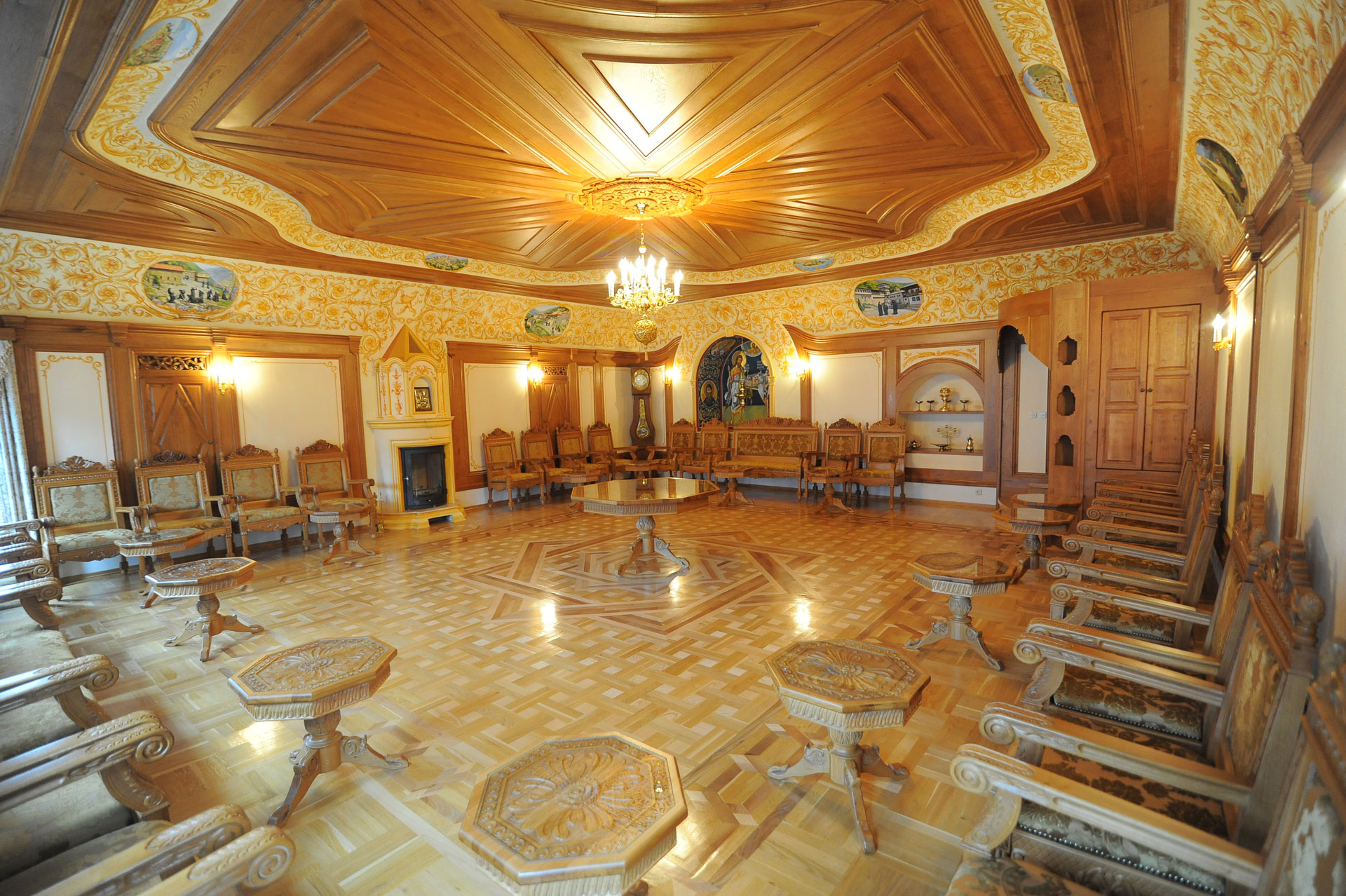

On the corner of the refectories building, touching the Upper Palace, is the main monastery kitchen, connected with a spacious bakery on the floor beneath, that makes the kitchen a functional unit of the building itself. Today this kitchen is a fully equipped functional space that meets the needs for welcoming and providing food for the increasing number of believers who regularly visit the services and the monastery.
On the 30-th of September, 2009, when the Holy Church celebrates the memory of the Holy Martyrs Faith, Hope and Love and Their mother Sophia, the Upper Palace was caught up by a tragic fire, leaving the monastery in a complete devastation. All the rooms and the interior furniture burned down and the only thing that remained were the stone monastery walls.
Thanks to the great self-sacrifice of the brotherhood and the believers present at that time, the valuable icons and objects from the monastic treasury were saved. Later as a result of the energetic and sacrificing efforts of the Abbot Parthenius, together with his brothers in Christ, and of the unselfish help of the believers, the Upper Palace was completely restored in its authentic glamour and shine.
The Seymen tower
West of the church there was another building called “Servants’ Building”, a hospice for monastic servants that was built in 1870 during the time of the Abbot Archimandrite Michael (1870-1894) and functioned as an accommodation place for the monastic assistants – servants. The ground floor served as a laundry room, because of its proximity to the springs, and on the floor above were the servants’ living rooms. The appearance of the building was characterized by a specific between-floors wooden construction with a very protuberant eave, which perfectly fitted this building in the monastery ambiance. During the 60-ies, of reasons unknown to us, this building was destroyed, and today there is a spacious concrete plateau, which opens the view of the visitors towards several, scattered mountain villages. In the immediate proximity of this building, is the so called “Seimen Tower” (Guards’ tower), where the seimens – guards used to live. This tower is fitted with unusual external stairs with a small covered porch, which fully revives its appearance. Nowadays, the upper floor of the tower is transformed into a small chapel dedicated to the holy new martyr St. George of Kratovo; the ground floor is a carpentry workshop while in the underground is the monastic candle workshop.
Nowadays, the upper floor of the tower is transformed into a small chapel dedicated to the holy new martyr, St. George of Kratovo.
The Ossuary
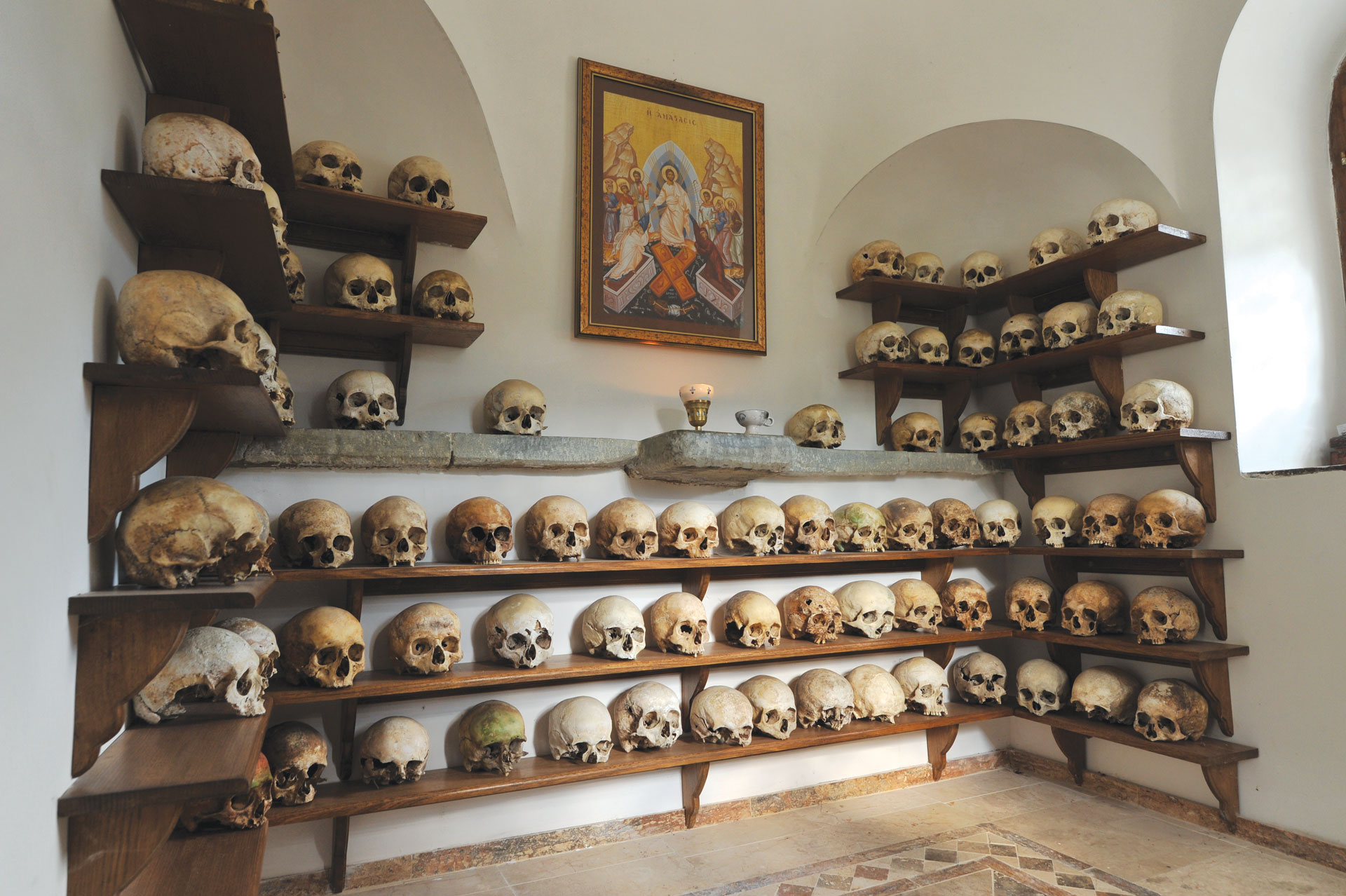
Another impressive building situated on the south of the church is the monastic ossuary built in 1827 of cut greenish stone, where the sculls and skeletal remains of the deceased monks are being kept. They were hidden in the ground beneath the floor, and were discovered in a wondrous way by the Bigorski brothers immediately after the re-consecration of the Catholicon, in the evening when the Holy Church celebrates the memory of the deceased. On some of the sculls the name, the repose day and the birthplace of the monk is noted.
The Lower Palace
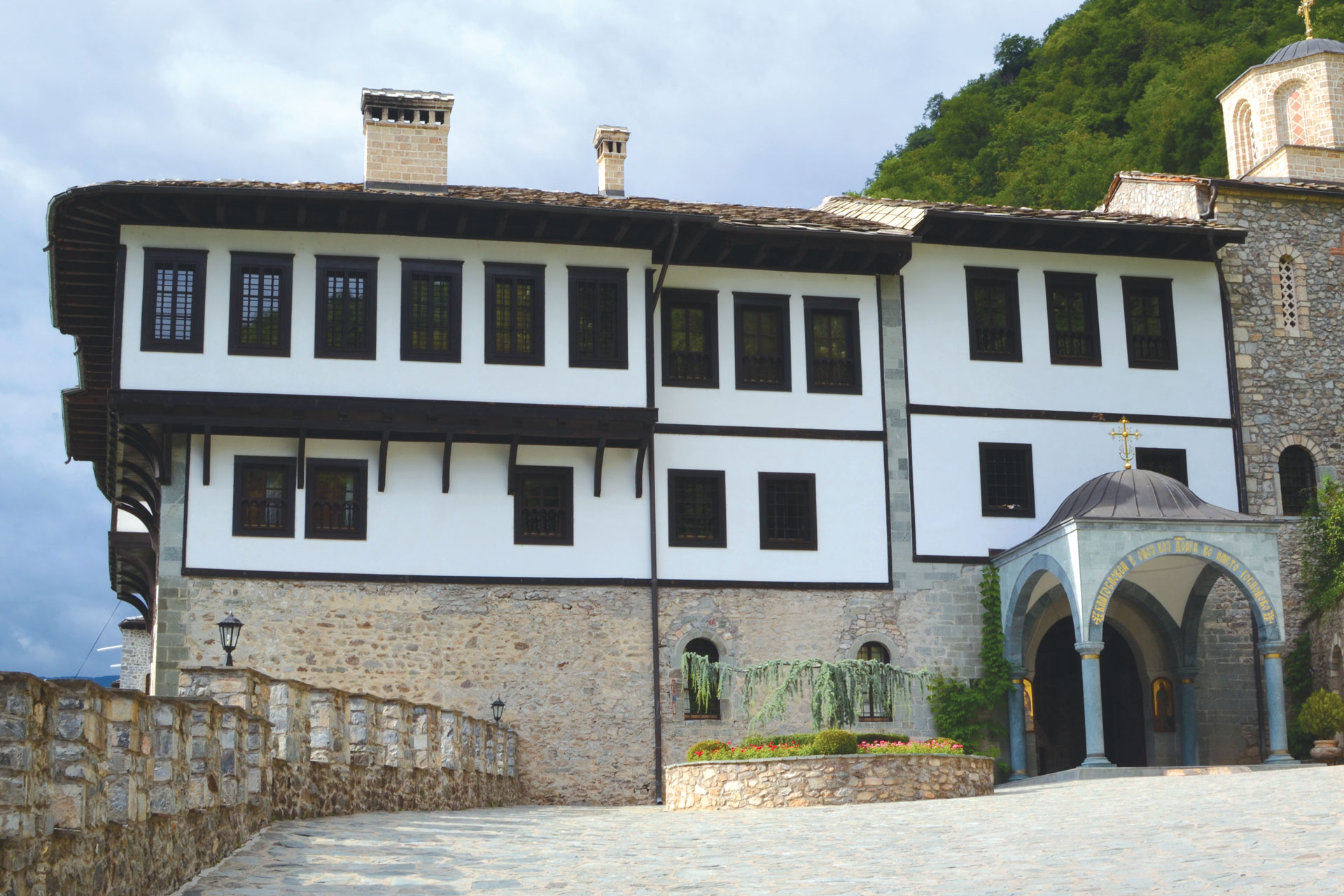
Right above the entrance of the monastery, there was a building called “Lower Palace”, which, unfortunately, got destroyed in a fire in 1912. The old building along with the rest of the hospices and buildings created a unique closed unity typical for the monastic lodgings made by the model of the athonite monasteries. This guest reception building distinguished itself by its particular artistic carvings of the doors and ceilings, different for each room, and was the work of masters from the village Lukovo, Drimkol area near Struga, well known for their exceptional gift for stone masonry. The building formed the entrance to the monastery in the shape of semicircular arcade, with a dragon shaped monastery fountains on the right side, as a unique decoration of this ancient sanctuary and especial architectural ornament. In 2006, with the painstaking efforts of Abbot Parthenius and the monastic brotherhood, the guest lodgings were restored and a new flat was added to this building, containing a beautiful chapel dedicated to The Annunciation, a Bishop’s chamber, Abbot’s chamber, a lavish internal balcony as well as a spacious opened balcony with an amazing sight. The interior of the Lower Palace corresponds fully with the authentic monastic ambience.
In 2006, with the painstaking efforts of Abbot Parthenius and the monastic brotherhood, the guest lodgings were restored and a new flat was added to this building containing a beautiful chapel dedicated to The Annunciation, a Bishop’s chamber, Abbot’s chamber, a lavish internal balcony as well as a spacious opened balcony with an amazing look towards the temple and the rest of the monastery complex.
The Eastern Palace
In 2007, driven by their efforts to restore the authentic appearance and the previous splendor of their sanctuary, as well as by the rising need of greater number of rooms for accommodation of the more and more increasing number of guests, the brothers of the holy Bigorski fraternity dedicated themselves to the building of another monastic building, called “Eastern Palace”. The new building was meant to give the monastery a complete finish, making it a whole, by the image of Mount Athos monasteries. For that purpose, in 2007 the building of an enormous supportive 800m long concrete wall started. In the summer 2009 they begun with the intensive building of the new monastic hospice, which was finished by the end of 2010. This building, with its exceptional architecture in Macedonian-byzantine style, so typical for the monastery, in a wonderful way complements and enriches the magnificence of the Bigorski Monastery. Here we have the impressive two- floor library with its unique interior, the chapel dedicated to St. Nickolas the Miracle-worker, the 8 bells clock tower which is an icon painting studio and archives, the lecture room, the Abbot’s loggings and the inescapable porch with a familiar appearance.
The Eastern Palace contains a two-floor library with its unique interior and a literary treasure of more than 30 000 ancient and new books as well as a chapel dedicated to St Nickolas the Wonderworker of Myra. On the south side there is a beautiful clock tower and a monastic iconographic studio on the top floor.
The Phiale

In 2008, a phiale was built in the southern part of the monastery yard – it’s an arcaded fountain for blessing water, with a marvelous archaic appearance that harmonically fits the overall exterior architecture of the monastery.
The phiale is completely painted in the style of byzantine iconographic tradition. Among the scenes presented inside the phiale, the most special place is given to the fresco of finding the miraculous icon of St. John The Baptist, which revealed itself to the first founder of the monastery – monk John of Debar; as well as scenes from the life and miracles of our Lord Jesus Christ connected with water, “The Live-Giving Fount of The Most Holy Theotokos”, “The Angel of Unity”, “St. John the Baptist”, “St. Cosma and Damian”, “St. Clement and Naum of Ohrid”, “St. George the Triumphant”, “St. Demetrios The Myrbearing, St. Nickolas The Wonderworker”, etc.
The renewed monastic fraternity, with God’s help, not only restored the former beauty of the ancient Bigorski sanctuary, but also, invested great love and eagerness and efforts to restore, enrich and garnish it to present glory.
The agiasma

A significant trace of ascetic life in the vicinity of the Bigorski Monastery are the water spring – agiasma and the anchorage, which are situated in the forest below the monastery. The prayers of the monks – hermits who lived here, consecrated these places and indulged our Lord so much, that the grace overflows even today, in the form of a spring of fresh water.
Every year on the first Friday after Easter the monastery fraternity goes down to the forest in a litany and blesses the spring of water in the agiasma dedicated to the East Friday – Balakli, the Life-giving Fountain of the Mother of God. Then the litany goes through the skete of St. Seraphim of Sarov, and returns to the monastery, while singing Paschal divine chants.



